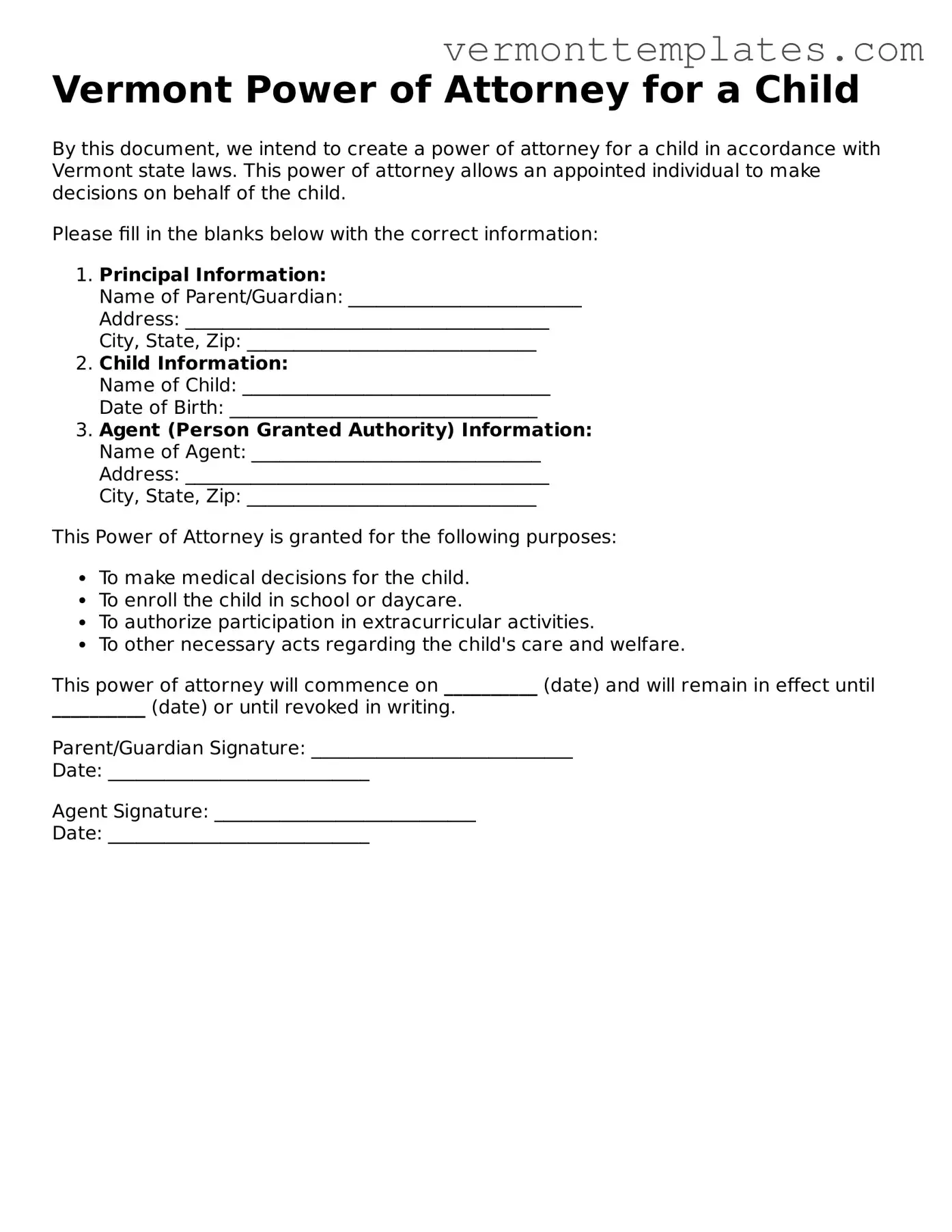The Vermont Power of Attorney for a Child form shares similarities with the General Power of Attorney. Both documents allow an individual to designate someone else to act on their behalf in various matters. However, while the General Power of Attorney can cover a wide range of issues, including financial and legal decisions, the Vermont form specifically focuses on the care and custody of a child. This means that the Vermont form is tailored to parental rights and responsibilities, ensuring that the designated person can make decisions regarding the child's welfare, education, and healthcare.
Another document akin to the Vermont Power of Attorney for a Child is the Child Custody Agreement. This agreement is typically used in divorce or separation situations to outline the arrangements for a child's living situation and visitation rights. While both documents address the child's care, a Child Custody Agreement is often more formalized and may involve court approval. In contrast, the Vermont Power of Attorney allows for a more immediate delegation of authority without the need for court intervention.
The Temporary Guardianship Agreement is also similar to the Vermont Power of Attorney for a Child. This document allows a parent to appoint someone to take care of their child for a specific period, often in situations where the parent is temporarily unable to do so. While both documents grant authority to another person, the Temporary Guardianship is usually limited to a set timeframe, whereas the Vermont form can be more open-ended, depending on the parent's wishes.
The Medical Power of Attorney is another related document. This form allows an individual to designate someone to make medical decisions on their behalf. While it typically pertains to adults, when it comes to children, parents can use a Medical Power of Attorney to ensure that their chosen representative can make healthcare decisions for their child. The Vermont Power of Attorney for a Child also includes provisions for healthcare decisions, making it a more comprehensive option for parents.
In addition, the Consent for Treatment form bears resemblance to the Vermont Power of Attorney for a Child. This document allows parents to give permission for medical treatment on behalf of their child. While the Consent for Treatment is often used for specific medical procedures, the Vermont Power of Attorney encompasses broader authority, allowing the designated individual to make ongoing decisions regarding the child’s healthcare needs.
The Adoption Consent form is yet another document that shares some common ground. This form is used when a parent agrees to place their child for adoption, relinquishing their parental rights. Although the intent of the Adoption Consent is to transfer custody permanently, the Vermont Power of Attorney for a Child temporarily delegates parental authority while maintaining the parent’s rights. Both documents require careful consideration, but they serve different purposes in the realm of child custody and care.
For individuals looking to establish clear operational guidelines for their business, an effective resource is the comprehensive Operating Agreement setup. This form not only clarifies roles and responsibilities within a Limited Liability Company (LLC) but also safeguards the interests of all members involved.
The Child Care Agreement is also similar in that it outlines the terms under which someone else will care for a child. This document can include specific details about daily routines, responsibilities, and expectations. While a Child Care Agreement often focuses on the practical aspects of childcare, the Vermont Power of Attorney for a Child grants legal authority, allowing the designated caregiver to make important decisions on behalf of the child.
The Standby Guardian Designation is another document that parallels the Vermont Power of Attorney for a Child. This form allows a parent to designate a standby guardian who can step in to care for the child in the event of an emergency or incapacity. Similar to the Vermont form, it ensures that the child’s needs are met without unnecessary delay. However, the Standby Guardian Designation is often activated only under specific circumstances, while the Vermont Power of Attorney can be used more broadly.
The Foster Care Agreement is also relevant, as it involves arrangements for the care of a child when parents are unable to provide that care. This document is typically used in more formal situations, often involving state agencies. In contrast, the Vermont Power of Attorney for a Child allows parents to choose a trusted individual without involving the state, providing a more personal approach to child care.
Lastly, the Educational Power of Attorney is akin to the Vermont Power of Attorney for a Child in that it allows a designated individual to make educational decisions on behalf of a child. This document can empower someone to enroll a child in school or make decisions regarding their educational needs. The Vermont form includes educational decision-making as part of its broader scope, making it a versatile option for parents looking to delegate authority.
